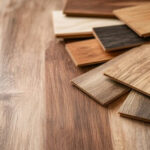This article on Hardwood Floor Installation The Ultimate Guide is meant for general overview purposes. You will find that this article does not have the nitty, gritty your hardwood flooring professional does. This is meant to give you an overview of how the process works, what the general processes are, and how to maintain the floor after completion.
Solid hardwood floor installation involves the process of installing solid wood planks as a flooring surface. This typically involves preparing the subfloor, laying a moisture barrier (if necessary), installing the first row of flooring along a straight edge, continuing to install the rest of the flooring by staggering the end joints and tapping the planks into place, trimming and installing the final row, and installing baseboards or quarter round molding to cover the expansion gap between the floor and the wall. Solid hardwood floor installation is a challenging project but will update your home while also increasing the value of your home. It’s important to carefully follow the manufacturer’s instructions for the specific flooring product being used and to get some practice cutting and installing a few planks before starting the actual project.
Steps Before a Hardwood Floor Installation Can Start
Choose a Wood
First things first are to decide which wood species would be right for you.
- Maple: Maple is a hard, dense wood with a tight grain pattern. It is known for its light color and subtle grain pattern, which can range from creamy white to light brown. Maple is resistant to wear and is a good choice for high-traffic areas.
- Hickory: Hickory is a hard, dense wood with a pronounced grain pattern. It is known for its distinctive, varied color, which can range from light to dark brown and can include shades of red and gold. Hickory is highly durable and is a good choice for high-traffic areas.
- White oak: White oak is a hard, dense wood with a medium to the coarse grain pattern. It is known for its light to medium brown color and distinctive grain pattern. White oak is resistant to wear and is a good choice for high-traffic areas.
- Red oak: Red oak is a hard, dense wood with a medium grain pattern. It is known for its light to medium red-brown color and distinctive grain pattern. Red oak is resistant to wear and is a good choice for high-traffic areas.
- Walnut: Walnut is a popular choice for hardwood flooring. It is a hard, dense wood with a medium to fine-grain pattern and a rich, dark brown color. Walnut is known for its unique grain pattern and natural beauty, and it can add warmth and character to a home. Please note if you drop something on the walnut it is prone to dent
Choose a Mill
While mills just produce the species of wood you are looking for, each mill has different aspects that make them better or worse. All wood is pretty close to the same price from log to log, however, the mill might take more time to prepare their wood. Rustic Floro Supply offers 3 different mills and we are confident in each and every one we sell.
Hillsboro: Great strip mill that produces a wonderful product that typically is higher grade and better-looking wood. The milling is nearly perfect for a great installation that will last decades.
Ten oaks: Offers sealed hardwood to ensure fewer moisture transfers to the wood over time. This helps ensure the wood does not move during the seasons as much as other companies.
WD: A cheaper mill that is called a strip mill. They cover smaller widths but at an extremely cheap price. The wood is slightly lower on the grading schedule, but the price is amazing.
Are there Stairs?
Premade stairs far out weight built site stairs. The reason is they are glued together and are cut and fit right into place. There is no need to sand or finagle with the creation of the stair. The stair can be installed and then finished on-site without much sanding. The stair will be flatter and nicer.
Common Steps of a Hardwood Floor Installation in Boise, ID
Sub Floor Preparation
Preparing the subfloor is an important step in the process of installing hardwood flooring. Here are some general steps to follow to prepare the subfloor for hardwood flooring:
- Clean the subfloor: Remove any dirt, debris, or old flooring from the subfloor.
- Check for levelness: Use a level to check the subfloor for levelness. If the subfloor is not level, use a self-leveling compound to smooth out any unevenness.
- Repair any damage: If the subfloor is damaged, repair it before installing the hardwood flooring. This may involve replacing damaged sections or filling in holes or cracks.
- Make sure the subfloor is dry: It’s important to make sure the subfloor is completely dry before installing the hardwood flooring. If the subfloor is damp, it can cause problems with the wood flooring.
- Buff any edges that are raised on the 4×8 sheets of plywood
Moisture Barrier
Moisture barriers are an important consideration when installing hardwood flooring, especially if the subfloor is concrete. Concrete can release moisture, which can cause problems for the wood flooring. If the wood absorbs too much moisture, it can expand and contract, leading to warping, cupping, and other issues.
A moisture barrier helps to protect the wood from moisture by creating a barrier between the concrete and the wood. This can help to prevent moisture-related problems with the flooring and ensure that it lasts for many years.
There are several types of moisture barriers that can be used, including plastic sheeting, underlayment, and paint-on moisture barriers. It’s important to follow the manufacturer’s instructions for your specific flooring product and to choose the right type of moisture barrier for your installation.
Proper Hardwood Floor Installation
Proper installation of hardwood flooring is important to ensure that the flooring is stable, durable, and looks good. Here are some general steps to follow for the proper installation of hardwood flooring:
- Install the first row of flooring: Start by laying the first row of flooring along a straight edge, such as a wall or chalk line. This row should be straight and parallel to the wall. Use a nail gun or adhesive to secure the flooring to the subfloor.
- Continue installing the flooring: Once the first row is in place, continue installing the rest of the flooring. Make sure to stagger the end joints of the planks by at least 6 inches to create a more visually appealing and stable floor. Use a tapping block and a hammer to tap the planks into place.
- Trim and install the final row: Once all the planks are in place, you may need to trim the final row to fit. Use a jigsaw or circular saw to cut the planks to size. Install the final row in the same way you installed the rest of the flooring.
What method of installation is best for Hardwood Floor installation?
Solid Hardwood
- Nails: Nails are typically used for solid hardwood flooring, which is made up of a single piece of wood. Nails help to hold the planks in place and provide additional stability to the flooring. Remember if the flooring is 5″ or higher the flooring will need a glue assist or a full glue application. Typically the NWFA recommends glue-assist installation.
- Subfloor type: The type of subfloor can also affect the decision to glue or nail the flooring. For example, if the subfloor is concrete, it may be necessary to use glue to help hold the flooring in place. On the other hand, if the subfloor is plywood or another type of wood, nails may be sufficient.
Engineered flooring:
With all engineered flooring we recommend that the flooring is glue assist with cleats or stales as a fastener. Glue ensures there are fewer cracks, squeaks or anything noise related. Engineered hardwood is susceptible to noise if the glue is not used.
Benefits of Having a Hardwood Floor Installed
Installing hardwood floors in a home can be a good idea for several reasons. Hardwood floors are generally very durable and can last for many years with proper care. They are easy to keep clean, as they don’t trap dirt and dust like carpet does. Hardwood floors are also hypoallergenic, as they don’t harbor allergens like pet dander, mold, and dust mites. In addition, hardwood floors have a natural beauty that can add warmth and character to a home. They are also versatile and can be stained and finished in a variety of colors and styles to complement a wide range of decors. Hardwood floors can also increase the value of a home and are often preferred by buyers. Of course, hardwood floors also have some drawbacks, such as cost and the need for regular maintenance, but for many people, the benefits outweigh the drawbacks.
Rustic Floor Supply highly suggests you find a flooring contractor from our list of flooring installers who buy from us daily. These installers buy professional-grade products, know their craft, and offer great service at an amazing price.
Hardwood Floor Installation FAQ’s and Videos for Boise, Idaho
Although the installation phase itself doesn’t typically generate dust, the removal of old flooring materials can. Even carpets can harbor a significant amount of dust and dirt. When carrying them outside, you’ll likely observe dust particles in the air. To minimize dust in areas where installation isn’t taking place, it’s advisable to use plastic barriers or coverings.
While DIY installation is possible for those with the right skills and tools, it’s often recommended to hire a professional to ensure a proper and long-lasting installation.
The best installation method depends on factors like the type of hardwood, the subfloor, and your preferences. Consult with a professional installer to determine the most suitable method for your specific situation.
Subfloor preparation includes ensuring it’s clean, level, and dry. Any imperfections should be addressed, and a moisture barrier may be necessary, especially over concrete.
Yes, you can install engineered hardwood floors over a concrete slab or in a basement because they are less prone to moisture-related issues compared to solid hardwood.
Yes, it’s essential to acclimate hardwood flooring to the room’s temperature and humidity for a specified period, usually around 3-7 days, to prevent expansion or contraction after installation.
Solid hardwood is typically nailed or stapled down, while engineered hardwood can be nailed, stapled, glued, or even floated, making it more versatile for various installation methods.
The installation time for hardwood floors varies based on the size of the area, the complexity of the job, and the type of installation. On average, it may take a few days to a week. Typically an installer does 300-500 sq ft a day depending on the width of the wood. This does not include the sanding portion.
Author Profile
- I have worked in hardwood flooring for the last 8 years. Use to run a company of residential crews as well as a company with gym flooring. If you need floor installation or refinishing help, I should have an answer or at least get you in the right direction.
Latest entries
 FlooringDecember 24, 2025Right Advice For Picking The Ideal Hardwood Flooring Options
FlooringDecember 24, 2025Right Advice For Picking The Ideal Hardwood Flooring Options FlooringDecember 22, 2025What is Your Favorite Type of Hardwood Flooring and Why?
FlooringDecember 22, 2025What is Your Favorite Type of Hardwood Flooring and Why? FlooringDecember 15, 2025What is the Most Durable Engineered Hardwood Flooring?
FlooringDecember 15, 2025What is the Most Durable Engineered Hardwood Flooring? FlooringDecember 12, 2025How Do You Maintain Vinyl Flooring in Spokane Homes?
FlooringDecember 12, 2025How Do You Maintain Vinyl Flooring in Spokane Homes?

